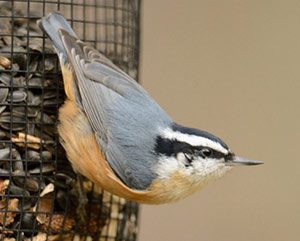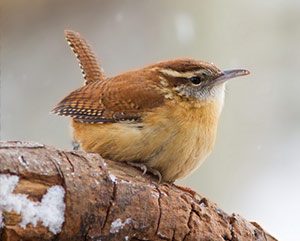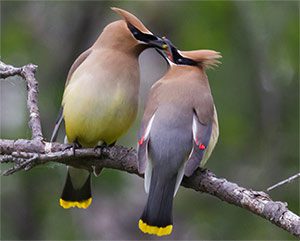Power Struggles Are Playing Out at Your Feeder—Here’s What to Look For
By Charles Eldermire and Hugh Powell
March 11, 2015Birds are doing a lot more than just feeding when they visit your bird feeder. They are coming and going and interacting with each other in a well-established social pecking order. At first it looks like just a flurry of activity—but watch closely and you’ll start to see the daily struggle of dominance playing out in your backyard. This slow-motion video walks you through one example to show you what to look for.
At your feeder, watch for when one bird changes its posture in the presence of another, or how some birds fly away altogether. Here’s a quick primer on three common dominance-related behaviors you might see. [Note: The videos in this post have been slowed down to one-half or one-quarter speed—things will happen a lot faster at your home feeders.]
Displacement. One of the most common and easiest to see behaviors, displacement occurs anytime one bird leaves to get out of the way of another bird. Displacement also plays out when one bird waits nearby for another bird to finish eating before flying over to a feeder. Within the same species, generally speaking, males tend to dominate females and older birds dominate younger ones. Feeder hierarchies can also involve birds of several species, with the larger species usually winning out over the smaller. In this example, a female Northern Cardinal lets a couple of White-throated Sparrows know when they’ve gotten a little too close to “her” sunflower seeds.
Threat Displays. Sometimes a dominant bird doesn’t need to displace a subordinate to exert influence. Watch for specialized threat displays designed to convey aggressive intent, such as the chickadee’s bill-up display in which he tilts his bill straight up. A dominant White-breasted Nuthatch performs a wing-spread display in which he sways side-to-side in the direction of the subordinate bird.
Appeasement. Dominant birds aren’t the only ones that signal their intent through behavior. Subordinate birds make appeasement displays that are the opposite of threat displays. Often, subordinates de-emphasize their size by showing a sleeker, smaller posture that seems to shy away from interaction. Watch for birds that deliberately lean or look away from a newly arrived bird, often while crouching or folding their wings in. When the dominant bird leaves, you may see the subordinate bird resume its normal posture.
Watch the posturing as these three Black-capped Chickadees work out their positions at the feeder. There’s some squabbling at the beginning, but notice how one chickadee ends up getting pushed to the windy, snowy side of the feeder and leans or edges away from further interactions. The two chickadees on the sheltered side seem to tolerate each other well and may be mates. (We also love the curious Northern Cardinal who seems to be observing the interactions almost as closely as a behavioral scientist would.)
Does Dominance Matter? When a dominant nuthatch occupies a feeder and forces the others to wait until he’s done eating, it’s more than just birdy bullying—it can be life and death. Research has shown that dominant birds forage in safer spots and at safer hours of the day (when there’s less predation). Accordingly, they get eaten by predators less frequently, are able to maintain a better body condition throughout the lean winter months, and have higher survivorship.
This last video helps illustrate another fact of biology: rules are rarely cast in stone, and birds often surprise you. Here, a Tufted Titmouse pushes a Black-capped Chickadee away from the favored side of the feeder—until a new arrival sends both birds packing.
Avian Sociability Index
You may have noticed that some birds at your feeder are more pugnacious than others. Some species seem to have different temperaments and regularly behave in either aggressive or submissive manners. Here are three examples:
 Feisty and Ready to Fight. Red-breasted Nuthatches are notoriously aggressive. While they’re about the same size as chickadees, Red-breasted Nuthatches will completely dominate chickadees whenever they get the chance.
Feisty and Ready to Fight. Red-breasted Nuthatches are notoriously aggressive. While they’re about the same size as chickadees, Red-breasted Nuthatches will completely dominate chickadees whenever they get the chance. Socially Unaware. Carolina Wrens appear to be utterly oblivious to other birds while camping out at a peanut feeder. They don’t move until they’re good and ready… unless a Blue Jay comes along.
Socially Unaware. Carolina Wrens appear to be utterly oblivious to other birds while camping out at a peanut feeder. They don’t move until they’re good and ready… unless a Blue Jay comes along. Happy Campers. If you’re looking for some good examples of avian dominance, don’t watch Cedar Waxwings. Entire flocks of 30-plus waxwings appear to get along swimmingly while feasting on the fruits of a crabapple tree.
Happy Campers. If you’re looking for some good examples of avian dominance, don’t watch Cedar Waxwings. Entire flocks of 30-plus waxwings appear to get along swimmingly while feasting on the fruits of a crabapple tree.
Resources for bringing birds into your backyard:
- Common Feeder Birds—interactive information on who to feed and what to feed them
- All About Birdhouses—complete information from our NestWatch project
- Feeder safety advice from Project FeederWatch
- Check out our Bird Friendly Homes articles about gardening and attracting birds
- Don’t have a feeder? We’ve got you covered online with the Cornell Lab of Ornithology livestreaming Ontario FeederWatch Cam and the Cornell Lab FeederWatch Cam.
Images via Birdshare: Red-breasted Nuthatch by JanetandPhil, Carolina Wren by Mike P, Cedar Waxwings by Roger P. Kirchen.

All About Birds
is a free resource
Available for everyone,
funded by donors like you
American Kestrel by Blair Dudeck / Macaulay Library

 Feisty and Ready to Fight. Red-breasted Nuthatches are notoriously aggressive. While they’re about the same size as chickadees, Red-breasted Nuthatches will completely dominate chickadees whenever they get the chance.
Feisty and Ready to Fight. Red-breasted Nuthatches are notoriously aggressive. While they’re about the same size as chickadees, Red-breasted Nuthatches will completely dominate chickadees whenever they get the chance. Socially Unaware. Carolina Wrens appear to be utterly oblivious to other birds while camping out at a peanut feeder. They don’t move until they’re good and ready… unless a Blue Jay comes along.
Socially Unaware. Carolina Wrens appear to be utterly oblivious to other birds while camping out at a peanut feeder. They don’t move until they’re good and ready… unless a Blue Jay comes along. Happy Campers. If you’re looking for some good examples of avian dominance, don’t watch Cedar Waxwings. Entire flocks of 30-plus waxwings appear to get along swimmingly while feasting on the fruits of a crabapple tree.
Happy Campers. If you’re looking for some good examples of avian dominance, don’t watch Cedar Waxwings. Entire flocks of 30-plus waxwings appear to get along swimmingly while feasting on the fruits of a crabapple tree.